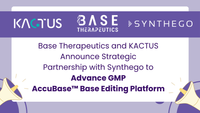Rewriting Life's Code: CRISPR Precisely Edits Blood Disorder Defects
By Tingxu Chen
Sickle cell disease (SCD) and transfusion-dependent β-thalassemia (TDT) are among the most common monogenic blood disorders, with approximately 300,000 new SCD cases and 60,000 new TDT cases diagnosed globally each year. Traditional allogeneic hematopoietic stem cell transplantation (HSCT) can offer >90% survival rates, but due to donor limitations, only a small fraction of patients have access to transplantation. Gene-editing technologies such as CRISPR-Cas9 - powered by advanced gene editing enzymes - offer revolutionary tools to develop one-time, curative gene therapies. At the end of 2023, Casgevy (exa-cel) became the world’s first approved ex vivo CRISPR gene-editing therapy for the treatment of SCD and TDT, marking a major transition from proof-of-concept to clinical application.
CRISPR Gene Editing Technology Platform
Editing Tools
“Genetic Scissors” – Cas Nucleases
A group of nucleases, such as Cas9, that induce double-strand breaks (DSBs) in DNA, triggering either non-homologous end joining (NHEJ) or homology-directed repair (HDR). These are suitable for gene knockouts or large-fragment insertions, but also carry risks such as off-target effects, chromosomal deletions, or translocations.
“Erasers” – Base Editors
Base editors create precise point mutations (C→T or A→G) by fusing a deaminase to a Cas9 nickase, avoiding double-strand breaks and associated risks of standard nucleases. This approach is often limited by random, off-target effects due the deaminase's non-specific activity. To overcome this, innovative platforms like AccuBase keep the deaminase inactive until it binds to the correct genomic site, significantly improving editing precision.
“Printers” – Prime Editors
Fusion of reverse transcriptase and Cas9 nickase. Uses pegRNA to mediate reverse transcription and insert single bases or small fragments. The efficiency is currently limited by reverse transcriptase, but prime editor design is rapidly evolving to improve efficacy.
Delivery Strategies
-
Electroporation: The CRISPR enzyme + gRNA complex, also called the ribonucleoprotein (RNP), is delivered into cells via electroporation, commonly used in in vitro and ex vivo gene-editing therapies.
-
AAV Vectors: Deliver the RNP using AAV vectors. Limited payload (<4.7 kb). Depending on the enzyme size, single or dual AAV systems are used. Different AAV serotypes offer tissue-specific targeting and are widely used in in vivo gene-editing therapies, though they are also applied in ex vivo contexts.
-
Lipid Nanoparticles (LNPs): A clinically validated platform for nucleic acid delivery, successfully utilized in untargeted mRNA vaccines. It is designed to encapsulate gene-editing components for effective in vivo delivery.
-
Virus-like Particles (VLPs): Can encapsulate and deliver Cas9 RNPs into cells. A newer delivery strategy primarily used for in vivo therapies.
Fig.1. Different delivery systems for therapeutic gene-editing machinery. (1)
Strategies for Developing Gene-Editing Therapies for β-Thalassemia
-
CRISPR-Cas9 Indel Editing: Introduce indels at the BCL11A enhancer to knock out or reduce BCL11A expression, reactivating fetal hemoglobin (HbF) to compensate for defective adult hemoglobin (HBB). Example: Casgevy.
-
Base Editing of BCL11A: Precisely modify a single base pair within the BCL11A +58 enhancer binding site. This disrupts GATA1 enhancement of BCL11A repressor protein expression, leading to increased fetal hemoglobin (HbF) expression and can functionally cure the disease by eliminating the need for transfusions.
-
Base Editing of HBG1/2 Promoter: Induce mutations to create transcription factor binding sites or disrupt BCL11A suppressor binding, promoting HbF expression to relieve TDT and SCD symptoms.
-
Correcting the HBB-E6V Mutation: Convert the pathogenic E6V mutation to a non-pathogenic E6A variant via base editing or use prime editing to directly correct the mutation and restore HbB expression.
-
Gene Knock-In: Insert correct sequences to replace the mutated gene. Cas9 induces DSBs, and the correct sequence is inserted using HDR pathways.
Table 1 summarizes 10 CRISPR-based clinical trials for blood disorders registered on ClinicalTrials.gov.
Off-the-Shelf Genome Editing Tools from KACTUS
Using the Cas9 RNP system, the same platform used in the approved therapy Casgevy, developers can rapidly create new gene-editing drugs by simply replacing the sgRNA, shortening the IND development timeline. The emergence of new CRISPR tools provides even more therapeutic options. KACTUS is committed to supplying high-quality gene-editing tools for cell and gene therapy developers. With a GMP-certified production facility spanning nearly 10,000 square meters and a robust quality management system, KACTUS offers a wide range of cutting-edge gene-editing enzymes in stock. Our GMP-grade Cas9 proteins are used across multiple drug development pipelines, from early R&D to clinical application. Our AccuBase® base editors, developed in-house by Baisencure and exclusively licensed to KACTUS for GMP production and commercialization, have received FDA IND approval for associated pipelines. These base editors have nearly zero off target effects because the deaminase is embedded inside the Cas protein so that the deaminase is only active upon RNP binding to the target sequence.
Talk to KACTUS about our off-the-shelf genome editing tools.
References
-
Current landscape of gene-editing technology in biomedicine: Applications, advantages, challenges, and perspectives. DOI: 10.1002/mco2.155
-
CRISPR-based therapeutic genome editing for inherited blood disorders. DOI: 10.1038/s41573-025-01236-y










